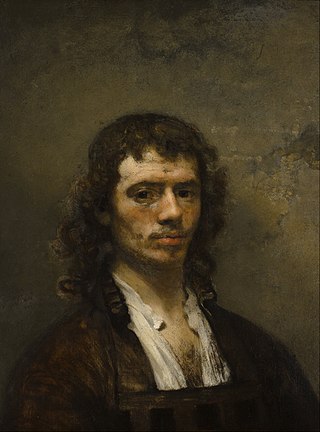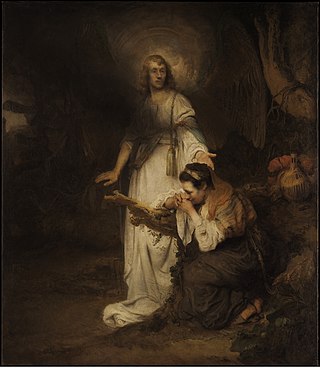Aelbert Jacobszoon Cuyp or Cuijp was one of the leading Dutch Golden Age painters, producing mainly landscapes. The most famous of a family of painters, the pupil of his father, Jacob Gerritszoon Cuyp (1594–1651/52), he is especially known for his large views of Dutch riverside scenes in a golden early morning or late afternoon light. He was born and died in Dordrecht.

Events from the year 1654 in art.

Carel Pietersz. Fabritius was a Dutch painter. He was a pupil of Rembrandt and worked in his studio in Amsterdam. Fabritius, who was a member of the Delft School, developed his own artistic style and experimented with perspective and lighting. Among his works are A View of Delft, The Goldfinch (1654), and The Sentry (1654).

Nicolaes Maes was a Dutch painter known for his genre scenes, portraits, religious compositions and the occasional still life. A pupil of Rembrandt in Amsterdam, he returned to work in his native city of Dordrecht for 20 years. In the latter part of his career he returned to Amsterdam where he became the leading portrait painter of his time. Maes contributed to the development of genre painting in the Netherlands and was the most prominent portrait painter working in Amsterdam in the final three decades of the 17th century.

Ferdinand Bol was a Dutch painter, etcher and draftsman. Although his surviving work is rare, it displays Rembrandt's influence; like his master, Bol favored historical subjects, portraits, numerous self-portraits, and single figures in exotic finery.

Rembrandt Harmenszoon van Rijn, usually simply known as Rembrandt, was a Dutch Golden Age painter, printmaker, and draughtsman. He is generally considered one of the greatest visual artists in the history of art. It is estimated Rembrandt produced a total of about three hundred paintings, three hundred etchings, and two thousand drawings.
Events from the year 1622 in art.

Carel van Savoyen or Carel van Savoy (1620/21–1665) was a Flemish painter, draughtsman and printmaker who was active in Antwerp and Amsterdam. He is mainly known for his history paintings and portraits but he also painted allegories and genre scenes.

View of Delft is an oil painting by Johannes Vermeer, painted c. 1659–1661. The painting of the Dutch artist's hometown is among his best known. It is one of three known paintings of Delft by Vermeer, along with The Little Street and the lost painting House Standing in Delft, and his only cityscape. According to art historian Emma Barker, cityscapes across water, which were popular in the Netherlands at the time, celebrated the city and its trade. Vermeer's View of Delft has been held in the Dutch Royal Cabinet of Paintings at the Mauritshuis in The Hague since its establishment in 1822.
Fabritius is a North European surname and Latin given name. Bearers of the name include:

The Goldfinch is a painting by the Dutch Golden Age artist Carel Fabritius of a life-sized chained goldfinch. Signed and dated 1654, it is now in the collection of the Mauritshuis in The Hague, Netherlands. The work is a trompe-l'œil oil on panel measuring 33.5 by 22.8 centimetres that was once part of a larger structure, perhaps a window jamb or a protective cover. It is possible that the painting was in its creator's workshop in Delft at the time of the gunpowder explosion that killed him and destroyed much of the city.

Hagar and the Angel is an oil-on-canvas painting of a scene from the Book of Genesis by Carel Fabritius, created c.1643–1645 during that artist's time in Rembrandt's studio or shortly afterwards. It is now in the Leiden Collection in New York.

Hera or Hera Hiding During the Battle Between the Gods and the Giants is a c. 1643 oil on canvas painting by Carel Fabritius, produced during his apprenticeship in Rembrandt's studio or shortly afterwards. It is now in the Pushkin Museum in Moscow.
Quentin Buvelot is a Dutch art historian. He works as the chief curator at the Mauritshuis in The Hague, and is regarded as a specialist in the painting of the Dutch Golden Age.

Ariane van Suchtelen is a Dutch art historian and museum curator, currently at the Mauritshuis.
Gero Seelig is a German art historian and curator based in Schwerin, Germany. He is the Old Masters Curator at the Staatliches Museum Schwerin, in Schwerin, where he has worked since 2001. He is specialized in German and Dutch artists from the sixteenth and seventeenth centuries and has published extensively on prints, drawings, and paintings from these periods.










